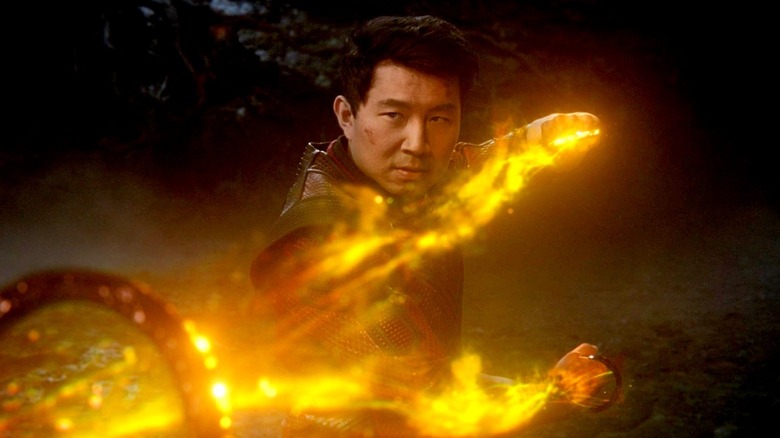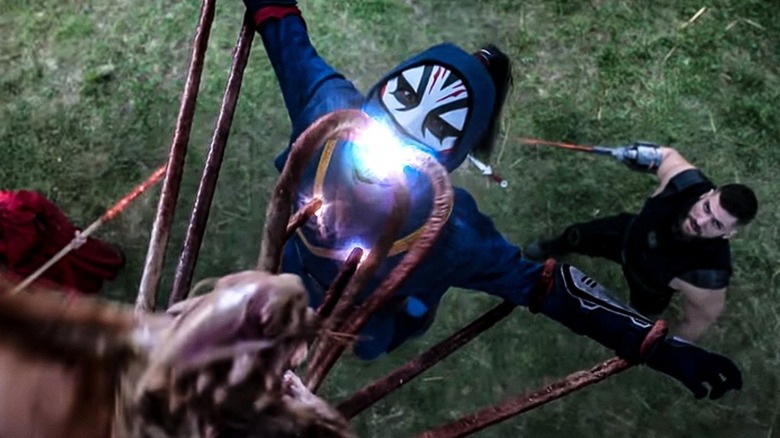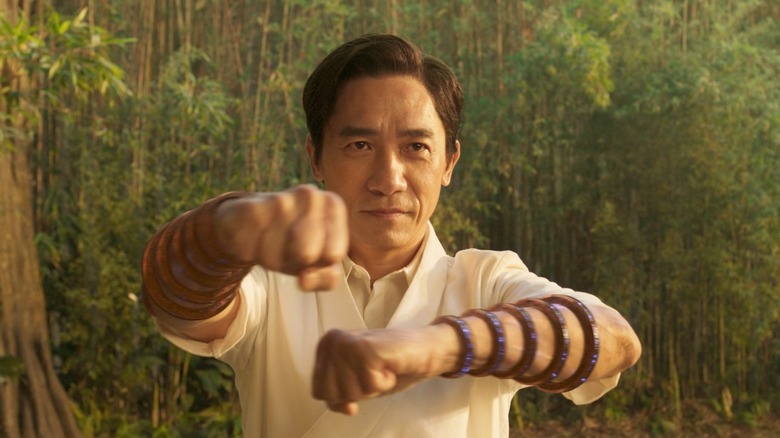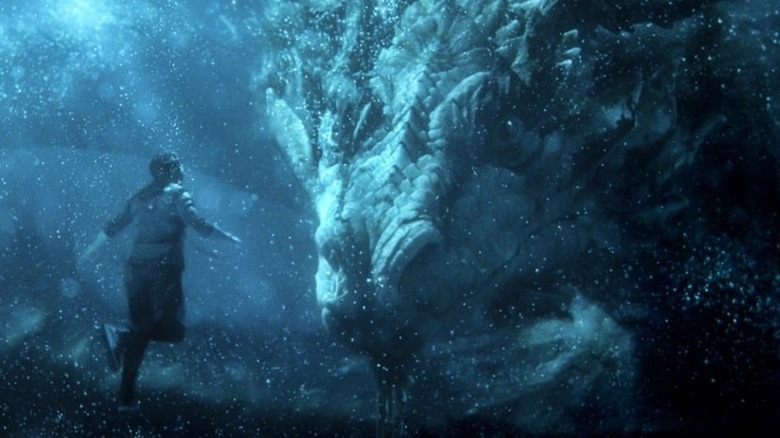Shang-Chi VFX Supervisor On Creating Dragons, The Rings, And The Mountain Of Souls [Interview]
Warning: This interview contains spoilers for "Shang-Chi and the Legend of the Ten Rings."
Weta had 350 artists working on Marvel's "Shang-Chi and the Legend of the Ten Rings." Most of their work was done on the third act, including the fight between the Great Protector and Dweller in Darkness, the battle between Shang-Chi and Xu Wenwu, and the action involving the Ten Rings. Even with two large scale dragons going at it in the sky, it was the rings, according to Weta Digital's visual effects supervisor, Sean Walker, that provided great difficulty.
Walker is a well-seasoned pro in the world of Marvel by this point. He was Weta's visual effects supervisor for "Black Widow" and "Avengers: Endgame." Prior to that, he was the CG supervisor on "Avengers: Infinity War," "Guardians of the Galaxy Vol 2.," and "Iron Man 3." Right now, Walker is keeping busy with upcoming blockbuster projects, but he recently made time to discuss the work that went into "Shang-Chi and the Legend of the Ten Rings."
'A Bit Of A Soul-Sucking Moment'
Is there a lot of communication between effects houses in terms of maintaining aesthetic consistency?
Yes, a lot actually. It does come down a lot to [senior visual effects supervisor] Chris Townsend. He has to oversee everything and make sure we are consistent in our looks, and we're all using the same lighting, and the same plates and grades. For the end sequence, because we started just after the fight between the villagers and the soldiers, we shared the village as an asset. No, in fact, we shared the entire environment as an asset. So Rising Sun Pictures built the replica of the on-set village. And we built the Mountain of Souls area, which is the other side of the lake. And so, we would build our part and they would build their part.
We would get together every once in a while. And if there were problems, which usually there are because we have our own sort of proprietary tools that we use to build things, then we would talk them through. And eventually, come to a final asset, which is just a giant package with all of our stuff to share with another vendor. I think TRIXTER actually had a few shots in there, as well. So they packaged both the Rising Sun's and our work to start TRIXTER's way too. It was a big team effort, I should say, between the three of us.
We've seen souls get sucked out of people before in movies, but it's done on such a large scale here. How's that effect achieved?
I know, there's just so many. It's an effect that has been done quite a few times. And I mean, even "Mortal Kombat," which came out earlier this year, had a bit of a soul-sucking moment in there as well. So we started out with a few different ideas. We really wanted to share something a little bit different. We started out with a whole variation of colors. We wanted to go almost rainbow-y with it in the beginning, with every chakra color that exists. We would see that flow inside the body as it came out, and then coalesce above the mouth or the head.
But then, it just became too colorful. It detracted from the moment. We toned it back a little bit. It is still quite colorful, but it's very subtle. So it's mostly hints of color and the white. And then, we added a bit of an echo to the body, so it wasn't just gas coming out. For example, when Death Dealer has his soul sucked out, you can see his actual body, an echo of his body get sucked out and form the coalesced soul above the head.
'The First Wingless Dragon We've Done'
How about for the dragon fight at the end? Where do you strike the balance between making them fantastical but also believable?
That is tough. So the beast, the Dweller in Darkness, and the dragon are obviously titan-sized creatures. The biggest things of that size is weight and scale. To sell the scale, there are a whole bunch of tricks we have where we'll make sure that there's context. So whether it's atmosphere, or things in the foreground, things that allow you to judge scale against. And then weight, just making sure that they're moving in a way that befits something so massive. And then shading, this is counter to my last point, but shading in detail to make them look real really helps for things of that size as well. Because you need details on their bodies that allow you to think that they're not just a couple of meters tall or the size of a person. So those are the main things we focus on with something so big.
How do you try to get across a sense of interior life for those creatures?
So the dragon was actually the first wingless dragon we've done. We've done a few dragons before. We did Drogon, Smaug, and I'm sure there've been a couple of others. Now, this is the first wingless one we had, so the dragon did need to express itself in a lot of ways, especially motion, especially in the way it flies. We kind of based it on a path-based animation.
So the dragon's head would be focused, and almost everything would be driven from that. We would have the tail kind of serpentine behind the head. We'd also break that path to make sure that you could really feel the dragon push and drive through the air, as if it was pushing through water. So that was how we animated the power into her. The other cool thing with that dragon, it was designed with fins, so that added a little extra layer of expressivity to her. She's just got kind eyes as well. We actually based her eyes off Fala Chen, the actress who played Shang-Chi's mother. It's a little bit more humanized than your normal dragon. There was a lot of expression we could play with there.
How does a decision like that, basing the dragon's eyes on Fala Chen's, come about?
Chris Townsend during the development stage of the dragon said, "It's a subtle thing, but we would like it if you could use Fala's eyes as a base." Obviously, we might have to deviate here and there just to get them to read and shot. But he sent us some footage of Fala from earlier in the film, because we didn't have her in any of our shots. So, they sent us some footage from that opening sequence, between her and Wenwu. We just used that as a base, especially for color.
What effects are more difficult than they look?
Do you know what? The rings. With the rings, there's no deformation in them. They all act as one. But no, they were deceptively difficult. Initially when we did a bunch of passes for them, we got a lot of notes back about the subtleties of how they should react. They should always just be a tiny bit behind the actor's motion. They need to be spinning at the right speeds. The arcs that they fly through need to be of a certain scale. There were a few things that we really need to dial in to get the motion of the rings right.
Do you ever experience limitations these days, in terms of what you can or cannot do?
Not really. I think you could pretty much do anything as long as you can think of it. It's just time. The main thing is you just need the time to be able to do it, I think. And even then, you can get almost anything done in a certain amount of time. It's just a trade off between quality, really.
'The Glowing is Just Visually Too Busy'
Any last minute changes you had to do for "Shang-Chi"?
There were a lot of changes. There was a lot of creative alterations throughout the production. Destin Daniel Cretton is a new director to visual effects. One of my main goals when talking to him, when starting out with Chris, was to kind of make this a good experience for him. We wanted to give him options, give him the ability to make those changes. So, we set up a flexible pipeline. We went through quite a few creative changes.
At one point, the dragon, the whole dragon itself was glowing in the same way that the mystical weapons do, because the scales come from her. So, we went through quite a few shots, rendered her out. And at a certain point, they're like, "No, the glowing is just visually too busy, and detracting from the rest of the story." Quite a few things that right up to the last moment, we were playing with. Just kind of ironing out everything that we thought needed it.
How much do you think a director actually needs to or should know about visual effects?
I don't think they have to know. I think that it is kind of the client side's, so in this case, Chris Townsend, part of his job is to help the director understand the implications of his decisions. So if the director says, "I want to do this or that," then Chris has to be able to say, "Yep, we can do that. It'll cost this amount, and take this amount of time." I think as long as there's good communication on their end, then I don't think the director has to know a whole lot. But then again, it does help if they know a little bit of visual effects going into it.
What breakthroughs in visual effects do you hope happens over the next few years?
I'm really liking where the visual production space is going right now. I know there are still some teething issues with some of the LED wall stuff that they're working on with, for example, "The Mandalorian." We've got our own LED wall technology that we're building, as well, and filming in right now. I think that's a good place to be. It makes our life a little bit easier. And also, when filmmakers go on to stage, there's not a lot of guesswork going on. I think that's the main thing, is that what they shoot in the camera is what they are hoping to put on screen. So, that's the biggest step that I think we should be taking next.
What about recreating actors? Are we closer to the reality presented in "S1m0ne"?
Oh yeah, absolutely. I think we've already had a couple of cracks at it. There's still some work to do in that space. But a hundred percent, I feel like the digital makeup is going to... what we're calling digital makeup, is going to be another big thing. You can have any actor you want, and as long as they can impersonate or act well, you can portray any actor you want.
[Update 11/2/21: A previous version of this article listed an unannounced project Walker was working on. That information has been removed.]



